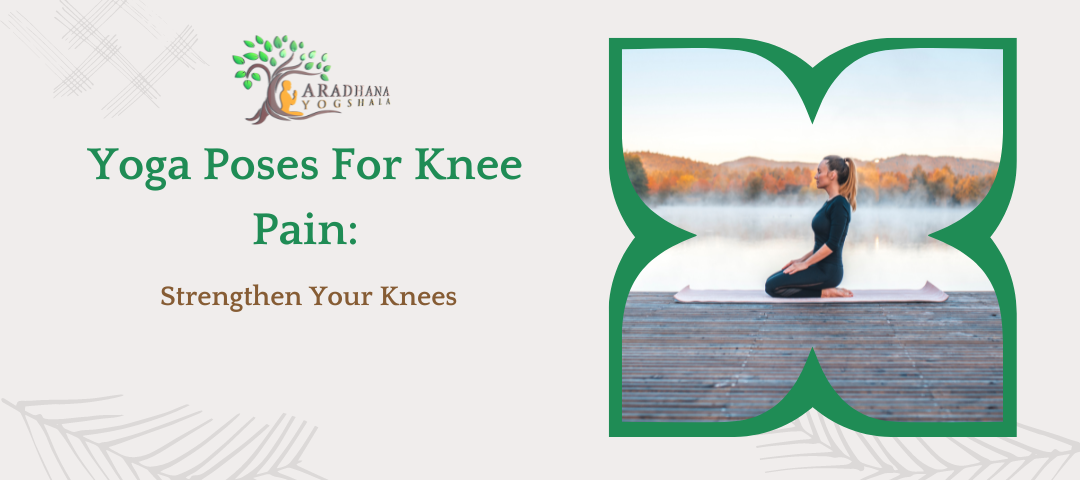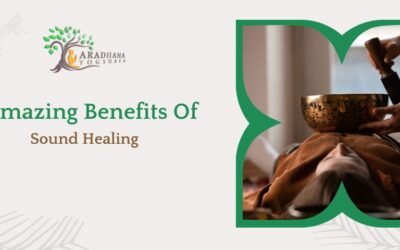In today’s fast-paced world, knee pain has become a common ailment affecting individuals of all ages. Whether it’s due to injury, arthritis, or general wear and tear, living with knee pain can be debilitating. It restricts our movement and disrupts our everyday routines. Nevertheless, by adopting a mindful and targeted approach, yoga can provide significant relief and contribute to the restoration of knee health. With its gentle yet effective techniques, yoga offers a range of exercises and poses that specifically target the knees, promoting flexibility, strength, and overall balance.
So to help you live a healthy and pain-free life, Aradhana Yogashala is excited to share with you a carefully curated selection of the best yoga poses for knee pain. These poses have been specifically chosen for their ability to relieve knee pain, improve joint stability, and promote healing. So, let’s discover the healing potential of yoga and empower your knees to reclaim their energy.
10 Best Yoga Poses To Relieve Knee Pain
Here are some carefully selected series of yoga poses for knee pain and their performing techniques, which provides both strength and relief.
1. Virasana (Hero Pose)
- Start by kneeling on the floor with your knees together and your feet slightly wider than hip-width apart.
- Lower your buttocks to sit between your feet, ensuring your heels are pointing outward.
- Rest your hands on your thighs or knees, keeping your spine upright.
- Stay in this position for several breaths, gradually increasing the duration over time.
Benefits: Virasana gently stretches the knees, thighs, and ankles, promoting flexibility and relieving stiffness. It helps improve circulation in the lower body and reduces swelling in the knees. Everyday practice of Virasana can enhance joint mobility and alleviate knee pain.
2. Baddha Konasana (Butterfly Pose)
- Sit on the floor with your legs extended in front of you.
- Bend your knees and bring the soles of your feet together, allowing your knees to fall to the sides.
- Hold your feet or ankles with your hands and sit up tall.
- Gently press your knees downward, feeling a comfortable stretch in the hips and inner thighs.
Benefits: Baddha Konasana opens up the hips and stretches the inner thighs, relieving tension and stiffness in the knees. It increases flexibility in the hip and knee joints and improves blood circulation in the lower body. Regular practice of this pose can alleviate knee pain caused by tight muscles or limited mobility.
3. Setu Bandhasana (Bridge Pose)
- Lie on your back with your knees bent and feet flat on the floor, hip-width apart.
- Place your arms alongside your body, palms facing down.
- Press your feet into the floor and lift your hips, creating a bridge shape with your body.
- Engage your glutes and inner thigh muscles as you lift your hips higher.
- Hold the pose for a few breaths, then slowly lower your spine back down to the floor.
Benefits: Setu Bandhasana strengthens the muscles around the knees, including the quadriceps and hamstrings. It helps stabilize and support the knee joints, reducing the risk of injury. This pose also stretches the chest and shoulders, improving overall posture and alignment, which indirectly benefits the knees.
4. Balasana (Child’s Pose)
- Start on your hands and knees, with your knees hip-width apart and your toes together.
- Sit back on your heels and lower your torso between your thighs.
- Extend your arms forward or rest them alongside your body, whichever is more comfortable.
- Relax your forehead on the mat and breathe deeply, allowing your body to soften.
Benefits: Balasana provides a gentle stretch to the hips, thighs, and ankles while also releasing tension and discomfort in the knees. It promotes relaxation and reduces stress, which can contribute to knee pain. Everyday practice of Balasana helps improve flexibility in the knees and enhances overall joint mobility.
5. Sukhasana (Easy Pose)
- Sit on the floor or a cushion with your legs crossed, placing each foot beneath the opposite knee.
- Keep your spine straight, and your shoulders relaxed.
- Rest your hands on your knees or thighs, palms facing up or down.
- Close your eyes and focus on your breath, allowing yourself to find a comfortable and meditative state.
Benefits: Sukhasana aligns the body and promotes a meditative state, which can help reduce knee pain associated with stress and tension. It encourages ease and improves overall posture, relieving pressure on the knees. Regular exercise of Sukhasana enhances mindfulness and supports the healing process for knee discomfort.
6. Vrikshasana (Tree Pose)
- Begin by standing tall with your feet hip-width apart.
- Shift your weight onto your left foot and bend your right knee, placing the sole of your right foot on the inner side of your left thigh or calf.
- Find your balance and bring your hands together in a prayer position at your chest.
- Lengthen your spine, engage your core, and find a focal point to help with balance.
- Hold the pose for a few breaths, then switch sides.
Benefits: Vrikshasana strengthens the muscles in the legs, including the knees and ankles. It improves stability and balance in the lower body, which can alleviate knee pain caused by instability. This pose also helps to open the hips, improving overall flexibility.
7. Utthita Parsvakonasana (Extended Side Angle Pose)
- Start in a wide-legged stance with your feet about 3-4 feet apart.
- Turn your right foot out to the right, keeping your left foot slightly angled inward.
- Bend your right knee, ensuring it aligns with your ankle while keeping your left leg straight.
- Extend your right arm down and place your right hand on the floor beside your right foot.
- Reach your left arm up toward the ceiling, creating a diagonal line from your left fingertips to your left heel.
- Hold the pose for a few breaths, then switch sides.
Benefits: Utthita Parsvakonasana stretches and strengthens the muscles around the knees, thighs, and hips. It increases flexibility in the groin and inner thigh muscles, reducing strain on the knees. This pose also improves stability in the legs, enhancing overall balance and coordination.
8. Trikonasana (Triangle Pose)
- Stand with your feet wide apart, about 3-4 feet.
- Turn your right foot out to the right at a 90-degree angle, and pivot your left foot slightly inward.
- Extend your arms out to the sides, parallel to the floor.
- Shift your hips to the left and reach your right hand down, placing it on your right shin, ankle, or the floor.
- Extend your left arm upward, creating a straight line from your left fingertips to your left shoulder.
- Gently gaze upward or straight ahead.
- Hold the pose for a few breaths, then switch sides.
Benefits: Trikonasana stretches and strengthens the muscles in the legs, including the knees, thighs, and calves. It increases flexibility in the hips and groin, reducing strain on the knees. This pose also helps improve posture and alignment, relieving pressure on the knees and promoting overall joint health.
9. Utkatasana (Chair Pose)
- Begin by standing tall with your feet together.
- Inhale and raise your arms overhead, parallel to each other, and palms facing inward.
- Exhale and bend your knees, as if sitting back into an imaginary chair. Keep your weight in your heels.
- Engage your core and lengthen your spine, avoiding any rounding of the back.
- Hold the pose for a few breaths, gradually increasing the duration over time.
Benefits: Utkatasana strengthens the muscles in the legs, including the quadriceps, hamstrings, and calves. It provides stability to the knees and helps improve balance and coordination. This pose also activates the core muscles, supporting the lower back and relieving stress on the knees.
10. Ardha Navasana (Half Boat Pose)
- Begin by sitting on the floor with your knees bent and your feet flat on the floor.
- Lean back slightly and lift your feet off the floor, bringing your shins parallel to the floor.
- Extend your arms forward, parallel to the floor, with your palms facing each other.
- Engage your core muscles and lengthen your spine, maintaining a straight back.
- Hold the pose for a few breaths, gradually increasing the duration over time.
Benefits: Ardha Navasana strengthens the core muscles, including the abdominal muscles that support the lower back and knees. It improves overall balance and stability, reducing the risk of knee injuries. This pose also engages the hip flexors, further enhancing the flexibility and strength of the lower body.
Conclusion
By incorporating these best yoga poses to relieve knee pain into your practice, you can experience increased strength, flexibility, and relief. These yoga asanas will help you to strengthen your knee and improve mobility.
So, let Aradhana Yogashala help you experience the transformative benefits of yoga poses for knee pain. Our expert yoga instructors in Rishikesh will guide you through a tailored practice that strengthens your knees, increases flexibility, and promotes overall well-being. It is not only your destination for relieving knee pain but also a hub for the best yoga teacher training courses and rejuvenating yoga retreats in Rishikesh. With a focus on alignment and modifications, we ensure a safe and supportive environment for all levels.
Get in touch with us by calling at +91-95575 91290 or emailing your query to info@aradhanayogashala.com. So, take the first step towards a healthier, happier life by joining Aradhana Yogashala today.
Related Blogs
9 Amazing Benefits Of Sound Healing
Are you aware that sound has the power to promote healing? Indeed, it's a reality! If you're in search of a method to relax and shed stress, sound healing might just be the solution you've been seeking. Sound healing is experiencing a rebirth in popularity. It is an...
Sound Healing: Harmonizing Your Mind, Body, And Soul For Optimal Well-Being
In today's fast-paced and stressful world, people constantly seek effective ways to promote their physical, mental, and emotional well-being. One technique that has gained significant attention in recent years is sound healing. Rooted in ancient practices and...
International Yoga Day: Experience The Best At Rishikesh’s Top Yoga School
International Yoga Day, celebrated on June 21st every year, is a global event highlighting yoga's importance in promoting holistic health and overall well-being. This day serves as a reminder of the transformative power of yoga and its ability to unite people from all...




